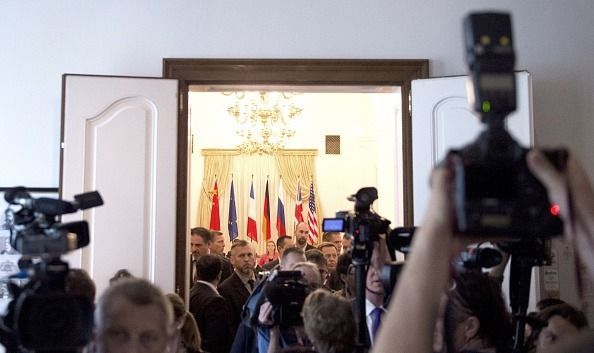After a historic nuclear agreement, challenges ahead for Iran
By Ariane Tabatabai | July 13, 2015

After months of intense negotiations and several extensions, Iran and six world powers finally reached a comprehensive nuclear deal on Tuesday in Vienna. The historic agreement accomplishes several things that benefit the non-proliferation regime and international security. It curbs Iran’s nuclear activities and allows the international community to verify that Tehran’s program is peaceful. In doing so, the deal stops a 10th country from developing nuclear weapons. It also allows Iran to take steps toward normalizing its political and economic relationship with the rest of the world. In short, both sides have reason to celebrate. As global attention moves on, though, Iran still faces major challenges ahead.
What was accomplished. While many back home on both sides have been pushing their negotiators to do better, it's important to remember that a deal can only be sustainable if both parties walk away feeling like they gained more than they conceded. Advocates of zero enrichment for Iran have missed this point all along, pushing for a full Iranian capitulation. Even if such a deal had been concluded—which wouldn’t have happened—it wouldn't have lasted.
The P5+1—China, France, Germany, Great Britain, Russia, and the United States—can now leave the negotiating table with the assurance that they have effectively checked sensitive Iranian nuclear activities. They have essentially closed off any possibility of Iran getting the Bomb using plutonium, by getting it to agree to redesign the Arak heavy water reactor, a virtually irreversible step, and formalizing Tehran’s pledge not to reprocess plutonium. The agreement also scales back Iran’s uranium enrichment program, limiting the activity to a single facility, Natanz, and reducing its capacity by two thirds. The Fordow plant, meanwhile, which was a key proliferation concern, is being repurposed as a research and development site. This step lengthens Iran’s breakout time, or the amount of time it would take between choosing to build a nuclear weapon and accumulating enough fissile material to do so.
The agreement, furthermore, includes a permitted procurement channel, so that Iran can continue working on its nuclear program without resorting to black market equipment. This means that Iran will get state-of-the-art technology, and ensures that the international community will know what Iran is doing and how it is doing it. Last but not least, the prospects of a so-called “sneak out” have been minimized: The Iranian nuclear program will be heavily monitored at all stages, from milling and mining all the way through to enrichment. The International Atomic Energy Agency will do the monitoring to ensure that Tehran complies with its obligations under the Comprehensive Safeguards Agreement and the Additional Protocol. (Iran is voluntarily implementing the latter under the deal, pending its formal ratification through the legislative process.)
With this level of scrutiny, the international community can make sure that Iran's nuclear program remains peaceful. It can also pat itself on the back for bringing a country back into compliance through a negotiated process, rather than yet another military solution. Even critics of the deal who were in favor of military intervention admitted that their option wouldn’t have been a lasting solution; some said the United States would have kept having to "mow the lawn," with all the costs that would have entailed. Instead, the United States and its negotiating partners walk away with what looks like a durable and effective solution to the Iranian nuclear crisis and a step forward for the non-proliferation regime.
The Iranian establishment, and especially Supreme Leader Ayatollah Khamenei, generated heated debate in the United States with some statements made over the course of negotiations. Many interpreted Khamenei's statements as redlines designed to derail the process. In fact, though, he helped the talks progress by managing expectations and balancing interests, while supporting his negotiators and shielding them from the harsh criticism of domestic opponents. Ultimately, Iranian negotiators met their regime’s requirements. Khamenei supervised the process, albeit without ever making that official. The fact that negotiators met the parameters fixed by Khamenei, presented by the Parliament, and supported by most of the political and security establishment, will facilitate implementation and make the deal more sustainable. Khamenei’s redlines—the non-negotiables—included not shutting down any nuclear facilities, not allowing inspections of military facilities, and not giving up research and development.
Beyond the nuclear issue. The agreement means the re-opening of a very lucrative market for foreign business. Following the 1979 Islamic Revolution, and particularly with the emergence of the nuclear crisis, Iran became one of the few countries in the world where, for the United States, politics trumped business interests. While in the short-term this is unlikely to change, in the long run, the nuclear deal is a beneficial first step toward promoting the interests of the Iranian business community in the United States. Indeed, the US web of sanctions remains extremely complicated, and while some will now be lifted, others will not, because of concerns over Tehran's human rights track record and support for outside terrorist groups. This means that Iran’s economy won't be fully normalized any time soon.
The agreement will, though, empower the administration of President Hassan Rouhani, who has pledged to reform his country's economy. It gives him much-needed political capital to work on a number of issues. He has already started to tackle domestic issues such as mismanagement and corruption within the Iranian economic system. But his efforts will take time to come to fruition. For one thing, the void left by foreign companies was filled by the paramilitary Islamic Revolutionary Guard Corp, or IRGC, in many areas. The guards are unlikely to give up control and let foreign companies take over the economy without a fight. Second, mismanagement and corruption won't disappear from the picture in Iran overnight. Rouhani can diminish the problem, but it will be a very slow process.
Iran’s citizens expect some economic recovery and also progress on other issues. Up until now, the Rouhani government could hide behind the nuclear negotiations. With that problem solved, it will have to take steps toward addressing other ones. In a July video message, Foreign Minister Javad Zarif set the tone for his ministry’s post-deal agenda: Tackling terrorism and dealing with regional security. The current team in the Foreign Ministry has made some attempts to engage with Iran's neighbors, including Saudi Arabia. With the deal in hand, Zarif can pursue further engagement with the region, to address security challenges including the Islamic State and in Iraq, Syria, and Yemen.
The Iran talks may be over, but that doesn’t mean that the chapter is entirely closed. The deal will have to win the approval of the US Congress, and Iran has to take agreed steps to curb its nuclear activities before receiving sanctions relief. Plus, it still has to wade through the aftermath of political and economic isolation. The Vienna deal is nonetheless worth applauding.
Together, we make the world safer.
The Bulletin elevates expert voices above the noise. But as an independent nonprofit organization, our operations depend on the support of readers like you. Help us continue to deliver quality journalism that holds leaders accountable. Your support of our work at any level is important. In return, we promise our coverage will be understandable, influential, vigilant, solution-oriented, and fair-minded. Together we can make a difference.















